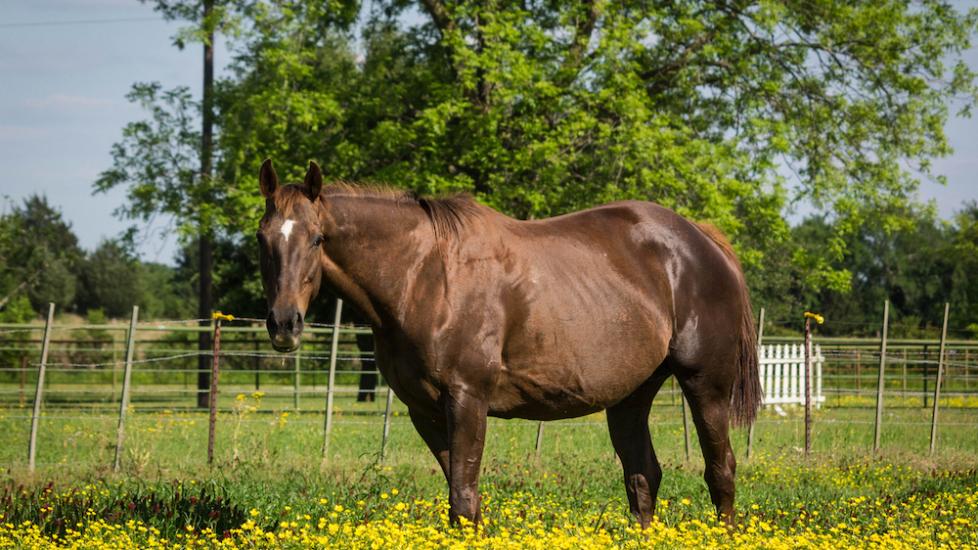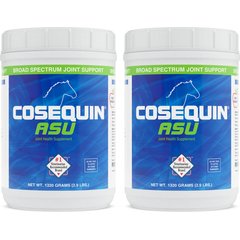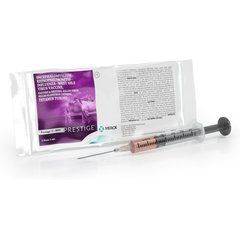Pregnancy in Horses
If your mare is pregnant, this is an exciting time of horse-ownership. Keeping your mare happy and healthy during this period is critical in giving her the best opportunity to develop and give birth to a thriving newborn foal. There are multiple stages of gestation, each with its own characteristic milestones, potential hazards, and maintenance needs.
When Can Horses Become Pregnant?
While some people begin breeding their horses as soon as a filly reaches sexual maturity (around 18 months of age), it is typically safer and recommended to wait until she is also fully grown skeletally, around 4–5 years old, to give her the safest chance to have a foal without any birthing difficulties. While many mares may be bred up into their 20s, it is more difficult for a mare to conceive for the first time during or after their teens, or if there has been a long period since the last pregnancy.
Mares are seasonal breeders, meaning they can be bred from late spring to early fall each year; their reproductive cycle is roughly 21 days in length for each breeding opportunity. Each cycle has a small window of a few days where the mare is receptive to a stallion, and an even smaller window when artificial insemination may be successful.
Shop Horse Products
- Tribute Equine Nutrition Kalm N' EZ Pellet Low-NSC, Molasses-Free Horse Feed, 50-lb bag$25.49Chewy Price
- Nutramax Cosequin ASU Powder Joint Health Supplement for Horses, 2.86-lb tub, bundle of 2$279.98Chewy Price
- Absorbine ShowSheen Instant Detangling Hair Polish & Detangler Horse Spray, 32-fl oz bottle$17.84Chewy Price
- Prestige 5 + WNV Vaccine for Horses, 1-mL syringe$53.99Chewy Price
How Long are Horses Pregnant?
The gestation period for a horse is 340 days on average, or about 11 months. Some mares may give birth earlier or later, particularly if they are a maiden (this is their first pregnancy), or if there are health issues as described below.
What to Expect When Your Horse is Pregnant
Similar to humans the horse pregnancy can be broken into three trimesters. Each phase has specific checkpoints to evaluate the health of both mare and fetus.
First Trimester: (0–~114 days gestation)
-
14–16 days: ultrasound confirmation of pregnancy, evaluate for twins. Twin pregnancies can lead to fetal death, major health risks for the mare, and can be potentially deadly for all three. For this reason, it is important to have your mare checked for twins at this stage after breeding; one twin can often be pinched (terminated) safely, and both mare and remaining fetus can continue the rest of gestation normally.
-
25–30 days: ultrasound check for viable fetus with heartbeat.
-
Early embryonic loss is common in the first 60 days of gestation. If there are any concerns of fetal viability, inadequate hormone production by the mare, or if she has a history of “slipping” pregnancies, your veterinarian may recommend hormonal supplementation with altrenogest (Regu-mate).
-
The first deworming can typically occur at 60–90 days of gestation.
-
Around day 60 or 90: ultrasound of healthy fetus, check placenta, potential sexing of foal can be performed at this time
-
Your foal is very active during the first trimester, potentially changing directions several times an hour.
-
Your mare may experience a decreased appetite or mild weight loss.
Second Trimester: day 114/120–226
-
Between 120–150 days, abdominal ultrasound can be attempted to sex the foal, although this is more difficult than the earlier attempt via rectal ultrasound due to foal positioning and movement.
-
Your mare’s appetite typically returns, and some weight gain begins.
-
The uterus drops lower in the abdomen as growth continues, and the fetus changes position to have the head pointing rear towards the cervix.
Third Trimester: day 226–birth
-
The mare’s nutritional requirements increase through this period, as the foal is growing rapidly the last few months of pregnancy. During the last 90 days, the fetus gains approximately one pound per day.
-
As the mare gets close to giving birth, her appetite may decrease slightly or that she lays down more often, trying to get the fetus in a more comfortable position. She may isolate more from her herd mates as well.
-
During the days leading up to parturition, your mare may have wax on her teats, and you will notice “softening” or relaxation of the muscles around the tail head and rear end in preparation for labor.
Medical Needs During Horse Pregnancy
Vaccines
Ideally, your mare will be up to date on her yearly vaccines prior to the breeding season. Vaccines should not be administered within the first 45–60 days of pregnancy to avoid stressing the immune system and leading to possible early embryonic death. Your mare should receive an equine herpesvirus vaccine at 5, 7, and 9 months of gestation, as this is a common cause of abortion in mares. In some areas or with at-risk mares, your veterinarian may recommend an additional start to this series at 3 months of gestation.
At 4–6 weeks before the foaling date, your mare should be given her yearly vaccines to allow for adequate antibody production so full immunity can be passed to her newborn foal. It is also good to have the mare moved to the place she’ll be giving birth around this time, if she isn’t already. This will allow her immune system time to encounter and become accustomed to any new pathogens in that environment before giving birth.
Deworming
Similar to vaccines, dewormers should not be administered during the first 60 days of pregnancy. Depending on your mare’s fecal egg count, she may normally require dewormer 2–4 times a year. It is often recommended to deworm before the breeding season, and again later in gestation. Your geographical location and mare’s fecal history may dictate another dose in the middle of gestation.
It is important to deworm your mare within the last few weeks of foaling. Mares are a common source of internal parasites for the foal, as some, like Strongyloides, can be passed through the milk. If your mare is not dewormed in the last few weeks of pregnancy, she can be dewormed shortly after giving birth, and this will provide similar protection to the newborn foal.
Nutritional Support
Maintaining a body condition score (BCS) of 5–6/9 is ideal for conception and pregnancy maintenance. Underweight mares have a higher likelihood of early embryonic loss the first two months. Overweight mares with a BCS of 7 or greater, especially if due to overfeeding, can lead to decreased insulin sensitivity and altered conformation of the foal.
Offering a mare proper nutrition throughout pregnancy is vital for the growth of the foal and health of the mare. The first and third trimesters have been found to be the most critical timeframes for maintaining a proper weight and body condition for a healthy foal.
While caloric needs may not drastically increase until the final trimester, ensuring your horse is on a well-balanced, nutritious diet the first several months is important. Most mares can be sustained on high-quality pasture and forage early in gestation if not exercising regularly.
Later in pregnancy, when the foal is growing rapidly, caloric needs increase and a mare/foal diet may be more appropriate for your horse. It’s important to consult with your primary veterinarian throughout gestation to ensure your horse is maintaining an appropriate condition for both her and her offspring.
Exercise: Can You Ride a Pregnant Horse?
If your horse is already conditioned and exercising regularly, she may continue to be ridden up to around 7/8 months gestation. Any stress (unnecessary travel), or vigorous exercise should be avoided in the first 60 days. Otherwise, continued light exercise and normal usage is healthy and often encouraged to keep your mare in a proper body condition and healthy.
Mares should be exercised minimally during the last 3–4 months of gestation. If they are out in a pasture, just walking or grazing through the day is sufficient. If you are unsure whether riding your mare may cause undue stress on her or the fetus, particularly if they have other ongoing medical issues, discuss this with your vet before exercising her.
Complications of Pregnancy in Horses
Abortion
There are many potential causes of abortion in the horse, both infectious and non-infectious. Clinical signs that may precede an abortion include early lactation or vaginal discharge. Some common causes include:
-
Equine Herpesvirus: one the most common cause of viral abortion in mares.
-
Equine Viral Arteritis is spread by infected carrier stallions and usually causes abortion in the first 30 days of pregnancy.
-
Twinning: the most common cause of non-infectious abortions; these typically occur around 8–9 months gestation.
-
Fescue toxicosis, caused by fescue (a grassy plant) infected with Epichloe coenophiala, can cause a wide range of complications during pregnancy, including decreased milk production, early separation of the placenta, longer gestation periods, and occasionally abortion. For precaution, most veterinarians will advise pregnant mares not to live on fescus pasture, especially the last three months of gestation.
-
Umbilical torsion, typically due to an abnormally long umbilicus, cuts off blood and oxygen supply to the fetus.
-
Mare Reproductive Loss Syndrome typically occurs in clusters, causing either early or late-term abortions, stillbirths, and weak foals. Other symptoms that may occur in the same time frame include colic, uveitis, and fibrinous pericarditis. While specific causes remain unknown, exposure to Eastern Tent Caterpillars seems to pose a significant risk for these abortion storms.
Abnormal Gestation Length
Some mares may hold on to their babies a bit longer, and it is not uncommon for a normal donkey gestation to last up to 12 to even 14 months. If a mare’s gestation lasts an unusually long amount of time, the foal may be postmature or dysmature. Premature or dysmature foals (those born at a normal or prolonged gestation but appear immature) will be:
-
Smaller than a typical foal
-
Might have a silky-smooth coat
-
Have a poor immune system
-
Have weak joints and muscles
-
Have floppy ears
Postmature foals, on the other hand, may have:
-
A longer coat
-
Teeth erupted already
This can occur due to placental insufficiency (the mare’s body doesn’t recognize the foal is ready), or if a mare has ingested tall fescue late in pregnancy. The longer a foal remains in the uterus after it’s ready, the higher the chances of fetal abnormalities and birthing complications, such as dystocias.
Other factors that may complicate pregnancy include inappropriate BCS, metabolic conditions, laminitis, Cushing’s, and chronic pain. These can make it more difficult for a mare to become pregnant, or to maintain a normal pregnancy without hormonal assistance.
How to Keep Your Mare Healthy During Pregnancy
Having a yearly wellness exam with your veterinarian is a great time to ensure she is up-to-date on all essential vaccines, that her teeth are in good shape to ensure she can eat well during pregnancy, and have a fecal exam performed to check for parasite load.
Maintaining an adequate body condition score (5–6/9) for most of the pregnancy will support healthy foal development and prepare her for a smooth delivery. This will include a balanced diet and appropriate exercise based on her normal activity level, and stress-free living conditions. Living on pasture is more natural for the horse’s gastrointestinal tract is more relaxing than staying confined in a stall for most horses.
About 4–6 weeks before her due date, it’s important to have a mare’s yearly vaccines boostered, and have her settled in the place she’ll be giving birth. This is helpful for both her stress level, and immune system exposure to local pathogens so she can pass off helpful antibodies to her newborn. Mares often end up foaling in the middle of the night, when it’s quiet and they’re undisturbed.
Once she’s getting close to foaling, having her in a stall under video surveillance, or keeping her at the vet clinic for monitoring in cases of high-risk pregnancies, allows you to watch for the beginning signs of labor without bothering her. When birthing begins, the mare should be watched carefully for any difficulties or abnormalities. If foaling at home, it is important to have a backup plan in case of emergency. Have your veterinarian’s number on hand and keep the trailer ready in case there are any concerns.
Featured Image: iStock.com/wordsatwork




